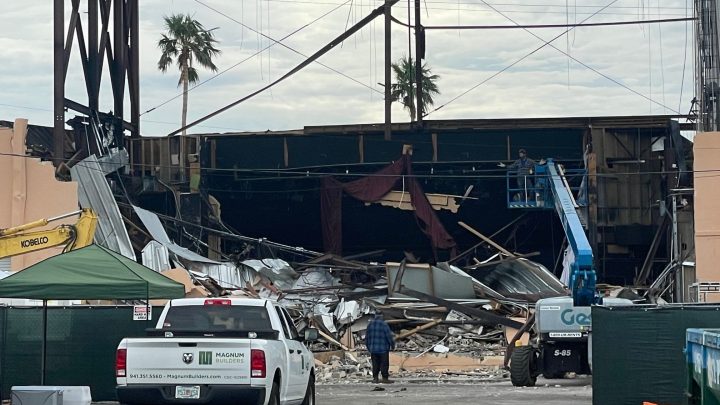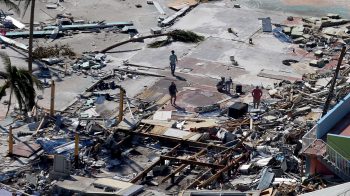
Florida cultural institutions are recovering from Hurricane Ian alongside homes and businesses
Florida cultural institutions are recovering from Hurricane Ian alongside homes and businesses

It’s been just about six weeks since Hurricane Ian hit southern Florida as a Category 4 storm.
Insurance claims in the state already top $8.4 billion and could reach close to 10 times that.
And all along the coast where Ian made landfall — from Naples in the south to Fort Myers and its barrier islands, and farther north, to Venice — repairs and rebuilding are underway for tens of thousands of homeowners and businesses, as well as a fair number of nonprofits.
A bridge on U.S. Highway 41, Southwest Florida’s main coastal highway, leads you into Punta Gorda, a small city jutting into Charlotte Harbor. Hurricane Ian made landfall nearby, and Punta Gorda suffered wind gusts of 135 miles an hour.
“We were right in the eye of it, so Ian was nothing to play with,” said Martha Bireda. “I mean, ancient trees uprooted.”

Bireda has weathered plenty of hurricanes here. She said Ian was the worst. Her house still isn’t habitable. And nor is the Blanchard House Museum of African American History and Culture that she runs nearby. The roof failed, the hundred-year-old building flooded, and fans have been drying it out. This reporter entered the building wearing a protective mask and smelled the water damage right away. Black mold could be seen along the walls, and part of the ceiling had fallen in.
Sitting outside on the Blanchard House’s porch, Bireda talked about the complexity of local African American history: “Punta Gorda has been said to have a unique sociology, because of the biracial settlement and development. In 1887, four African Americans incorporated this town. And we know in 1885 some of the harshest Jim Crow laws were passed.”
The museum is a stop on Florida’s Black Heritage Trail. An upcoming exhibit, Florida African American History 101, will tell the stories of Black conquistadors and escaped slaves in the Seminole Wars.
The museum usually gets about 600 visitors per year. Without them, donations at the door have dried up, Bireda said.
“We are a special little house. We are an educational institution, we share untold and untaught history, we do our own research. We are important in this community, in the state of Florida and in this country, because we tell these stories.”
Other Southwest Florida cultural institutions also took hits. Site prep for a new home for the Sarasota African American Arts Center and History Museum was delayed because power lines couldn’t be put in as scheduled after major utility damage in the region. Vickie Oldham, president of the Sarasota African American Cultural Coalition, said historical tours, including her institution, the Blanchard House and others, have been on the rise in recent years.
“Communities across the country are now realizing the importance of showcasing African American history,” Oldham said. “This is cultural tourism.”
On the waterfront in downtown Fort Myers, the Florida Repertory Theatre went dark for several weeks after it was battered by wind and water from Hurricane Ian. And about 40 miles up the coast from Punta Gorda, the storm nearly destroyed a cultural landmark in Venice.
“From here, you would have seen ‘Venice Theatre’ in really large letters, and that would have been your gateway into Venice driving over the bridge,” said Laurie Colton, Venice Theatre marketing director.
She was standing in the parking lot behind the Venice Theatre, pointing to an empty frame of steel girders soaring into the air more than 60 feet high — all that’s left of the main-stage area at the rear of the building. Executive Director Murray Chase said the back walls and roof of the theater, built in 1926, collapsed in the storm. Construction workers have been hauling away the wreckage.

“They’ve had to pull out most of the drywall, all of the flooring, they had the big drying tubes inside — get rid of any possibilities of mold,” Chase said. The storm also destroyed the main power conduit to the building, so there was no power for lighting or HVAC systems for weeks after Hurricane Ian hit, including for a newly renovated lobby and an adjacent small theater that weren’t directly damaged by the storm.
Chase said they’ll rebuild to current building codes to withstand major hurricanes in the future. “1926 code was basically no code,” he said. “One might be surprised it held together for 96 years because it was a brick-and-mortar wall. But we weren’t expecting 115-mile-an-hour winds for seven consecutive hours.”
Chase estimated that recovery and rebuilding, plus decontaminating whatever costumes and props can be salvaged, will cost $1 million to $1.5 million. Most of it will come from insurance, but it will likely take a year or more. So all the big shows of the fall-winter-spring season — which would usually sell out in the 450-seat main-stage theater — are canceled: “A Christmas Carol,” “Gypsy,” “Death of a Salesman.”
“We’ll lose in ticket revenue just under $3 million,” Chase predicted. “We’re going to be leaning on our community to get us through the next year.” Chase estimated that Venice businesses will lose at least that much.
Meanwhile, in Punta Gorda, Martha Bireda thinks it’ll be early next year before the Blanchard House Museum can reopen.
“We know the whole roof has to come off,” she said. “Our floors have been damaged. Eradicating all of that mold — those are our exhibit walls. It will be costly for us. But we will come back.”

There’s insurance — though the museum will have to raise at least $6,000 to pay deductibles. Plus, there’ll be costs to put exhibits online during rebuilding. But Bireda said she’s confident supporters will come through.
There’s a lot happening in the world. Through it all, Marketplace is here for you.
You rely on Marketplace to break down the world’s events and tell you how it affects you in a fact-based, approachable way. We rely on your financial support to keep making that possible.
Your donation today powers the independent journalism that you rely on. For just $5/month, you can help sustain Marketplace so we can keep reporting on the things that matter to you.

















